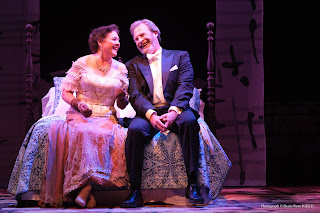Ensemble Music Society's 2025 opens with a spirited return by Imani Winds
With the Indiana History Center audience swelled by young people because of the guest ensemble's recent residency at Butler University, the Imani Winds did not forget "auld acquaintance" in its New Year's appearance Wednesday night for Ensemble Music Society.
Enthusiastically received from the moment it walked onstage, the quintet delivered an effervescent performance supplemented by pianist Michelle Cann. The program's substantial novelty involved her in a piece by Imani co-founder Valerie Coleman, who was its flutist before retiring to concentrate on composition.
 |
| Imani Winds: Kevin Newton (from left), Monica Ellis, Brandon Patrick George, Toyin Spellman-Diaz, Mark Dover. |
In Coleman's "Portraits of Langston," bassoonist Monica Ellis took on the narration, for which she was well-suited. The poetry of Langston Hughes was interspersed among the five movements, which were played by Brandon Patrick George, flute, and oboist Toyin Spellman-Diaz, oboe, in addition to Cann.
The music had a deft way of representing the scene-painting typical of Hughes' writing, ending with a calm sketch called "Harlem's Summer Night." The piano was silent now and then, especially meaningful in the Prelude, a respectful duo portrait of Helen Keller, the early 20th-century celebrity who surmounted blindness and deafness to become a venerated international figure.
The only imbalance between words and music came with "Le Grand Duc Mambo," in which the players fittingly summed up a Paris nightclub riot sparked by anti-feminist feelings — an altercation that took the verbal matter too long to relay. "Jazz Band in a Parisian Cabaret" seemed much better related to Hughes' celebration of a form of entertainment that 20th-century Frenchmen found readily appealing.
Musically, it's no dry January when Imani Winds holds the stage. That was clear from the exuberant program-opener, "A Little Cuban Waltz," by Cuban emigré Paquito D'Rivera. The waltz meter is pushed and pulled as riotous colors proliferate. Ellis seemed to be master of the revels, expressive in both movement and sound. Mark Dover made the most of a jazz-inflected showcase for clarinet in the middle before the ensemble reconvened to wrap up the wild dance. A companion piece on this occasion was Lalo Schifrin's "La Nouvelle Orleans," a picture postcard in musical styles that percolated in historic New Orleans, especially in its unique way of conducting street funerals.
Francis Poulenc, as the only composer featured with no American connection, was represented in Cann's initial appearance, together with Ellis and oboist Toyin Spellman-Diaz. The passionate tune of "Trio"'s second movement was nicely woven together, as the three players displayed the exquisite balance that was on display throughout the concert. In the finale, the coordinated slowing at cadences lent a special character to Poulenc's typical charm.
Poulenc's masterpiece in chamber music, Sextet, often known by the French equivalent, "Sextuor," concluded the concert in splendid fashion. It represents the secular savoir faire as well as the spiritual outreach of its flamboyant composer. It brought together the unanimity of interpretation Imani has developed for decades along with the sympathetically projected verve of the group's new collaborator, Cann.
All told, the Imani Winds demonstrate that they are focused, they are intense. The performers' sound burst from their instruments and flourished in the hall's fine acoustics. The space above Imani Winds' heads in the photo above suggests Sister Rosetta Tharpe's declaration: "Up above my head, I hear music in the air." It was certainly there shimmering Wednesday evening.


Comments
Post a Comment